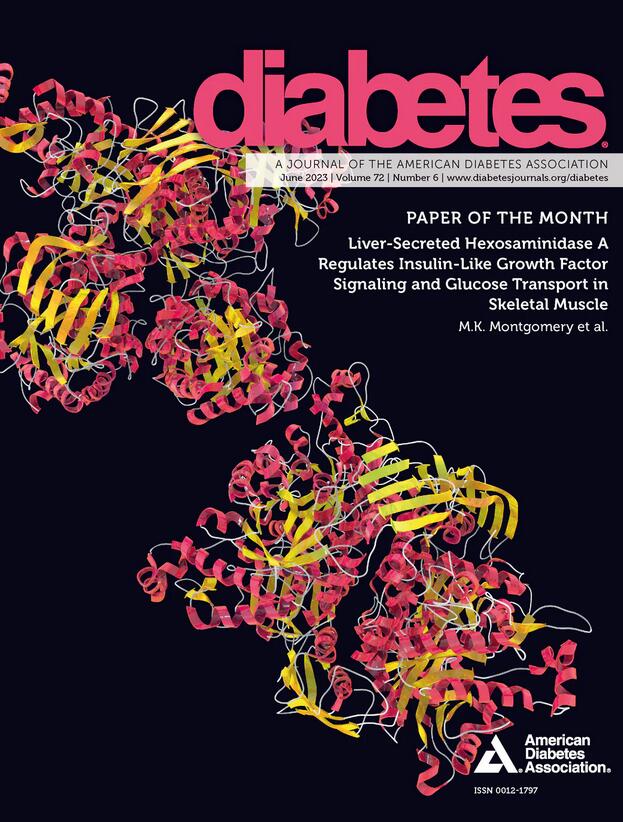IER3IP1 mutations cause neonatal diabetes due to impaired proinsulin trafficking
IF 6.2
1区 医学
Q1 ENDOCRINOLOGY & METABOLISM
引用次数: 0
Abstract
Immediate early response 3 interacting-protein 1 (IER3IP1) is an endoplasmic reticulum resident protein, highly expressed in pancreatic cells and the developing brain cortex. Homozygous mutations in IER3IP1 have been found in individuals with microcephaly and neonatal diabetes, yet the underlying mechanism causing beta cell failure remains unclear. Here, we utilized differentiation of genome edited-stem cells into pancreatic islet cells to elucidate the molecular basis of IER3IP1 neonatal diabetes. Using CRISPR-Cas9, we generated two distinct IER3IP1-mutant human embryonic stem cell lines: a homozygous knock-in model of a patient mutation (IER3IP1V21G), and a knockout model (IER3IP1-/-). While these mutant stem cell lines differentiated normally into definitive endoderm and pancreatic progenitors, we observed that IER3IP1-KO stem cell derived-islets (SC-islets) presented a significant decrease in beta cell numbers and elevated ER stress. Retention Using Selective Hooks (RUSH) assay revealed three-fold reduction in ER-to-Golgi trafficking of proinsulin in IER3IP1 mutant beta cells. Additionally, IER3IP1 mutant SC-islets implanted into immunocompromised mice displayed defective human insulin secretion, indicating the deleterious impact of IER3IP1 mutations on beta cell function. Our study provides valuable insights into the role of IER3IP1 in human beta cell biology and establishes a useful model to investigate ER-to-Golgi trafficking defects within beta cells.IER3IP1 基因突变会导致原胰岛素运输受损,从而引发新生儿糖尿病
即刻早期反应 3 相互蛋白 1(IER3IP1)是一种内质网常驻蛋白,在胰腺细胞和发育中的大脑皮层中高度表达。在小头畸形和新生儿糖尿病患者中发现了 IER3IP1 的同基因突变,但导致β细胞衰竭的潜在机制仍不清楚。在这里,我们利用基因组编辑干细胞向胰岛细胞的分化来阐明 IER3IP1 新生儿糖尿病的分子基础。利用CRISPR-Cas9,我们生成了两种不同的IER3IP1突变人类胚胎干细胞系:一种是患者突变的同基因敲入模型(IER3IP1V21G),另一种是基因敲除模型(IER3IP1-/-)。虽然这些突变干细胞系正常分化为明确的内胚层和胰腺祖细胞,但我们观察到IER3IP1-KO干细胞衍生小体(SC-islets)的β细胞数量显著减少,ER应激升高。使用选择性挂钩(RUSH)保留测定显示,在IER3IP1突变体β细胞中,胰岛素从ER到高尔基体的转运减少了三倍。此外,IER3IP1突变体SC-小鼠植入免疫缺陷小鼠体内后显示出人体胰岛素分泌缺陷,这表明IER3IP1突变对β细胞功能产生了有害影响。我们的研究为了解IER3IP1在人类β细胞生物学中的作用提供了宝贵的见解,并为研究β细胞内ER到高尔基体的贩运缺陷建立了一个有用的模型。
本文章由计算机程序翻译,如有差异,请以英文原文为准。
求助全文
约1分钟内获得全文
求助全文
来源期刊

Diabetes
医学-内分泌学与代谢
CiteScore
12.50
自引率
2.60%
发文量
1968
审稿时长
1 months
期刊介绍:
Diabetes is a scientific journal that publishes original research exploring the physiological and pathophysiological aspects of diabetes mellitus. We encourage submissions of manuscripts pertaining to laboratory, animal, or human research, covering a wide range of topics. Our primary focus is on investigative reports investigating various aspects such as the development and progression of diabetes, along with its associated complications. We also welcome studies delving into normal and pathological pancreatic islet function and intermediary metabolism, as well as exploring the mechanisms of drug and hormone action from a pharmacological perspective. Additionally, we encourage submissions that delve into the biochemical and molecular aspects of both normal and abnormal biological processes.
However, it is important to note that we do not publish studies relating to diabetes education or the application of accepted therapeutic and diagnostic approaches to patients with diabetes mellitus. Our aim is to provide a platform for research that contributes to advancing our understanding of the underlying mechanisms and processes of diabetes.
 求助内容:
求助内容: 应助结果提醒方式:
应助结果提醒方式:


